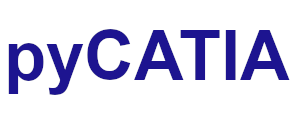pycatia.manufacturing_interfaces.manufacturing_pattern¶
Module initially auto generated using V5Automation files from CATIA V5 R28 on 2020-09-25 14:34:21.593357
Warning
The notes denoted “CAA V5 Visual Basic Help” are to be used as reference only. They are there as a guide as to how the visual basic / catscript functions work and thus help debugging in pycatia.
- class pycatia.manufacturing_interfaces.manufacturing_pattern.ManufacturingPattern(com_object)¶
Note
CAA V5 Visual Basic Help (2020-09-25 14:34:21.593357)
System.IUnknownSystem.IDispatchSystem.CATBaseUnknownSystem.CATBaseDispatchSystem.AnyObjectManufacturingInterfaces.ManufacturingFeatureManufacturingPatternThe Manufacturing Pattern is a specialized feature used to machine the sameitem several times at several positions.- activate_point(i_point_number: int) None¶
Note
- CAA V5 Visual Basic Help (2020-09-25 14:34:21.593357))
- o Sub ActivatePoint(short iPointNumber)Activates a point of a Manufacturing Pattern.Parameters:iPointNumberThe number of the point to activate.Example:The following example activates the point number 2 of themanufacturing pattern mfgPattern:call mfgPattern.ActivatePoint(2)
- Parameters:
i_point_number (int) –
- Return type:
None
- add_part_surface(i_part_surface: AnyObject, i_product: Product, i_notify: int) None¶
Note
- CAA V5 Visual Basic Help (2020-09-25 14:34:21.593357))
- o Sub AddPartSurface(AnyObject iPartSurface,Product iProduct,short iNotify)Adds a Part Surface to the Manufacturing Pattern.Parameters:iPartSurfaceThe part surface to be added.iProductThe product containing the part surface to add.iNotifyThe flag to specify if a refresh of the visualization is needed.Usually, this parameter is set to 1. In the case of a loop, it should be set to1 only on the last call of the method.Legal values: The parameter can be0no notification is sent1a notification is sentExample:The following example adds the part surface ‘TopPlane’ to themanufacturing pattern mfgPattern:call mfgPattern.AddPartSurface(TopPlane,Product1,1)
- add_position(i_position: AnyObject, i_product: Product, i_notify: int) None¶
Note
- CAA V5 Visual Basic Help (2020-09-25 14:34:21.593357))
- o Sub AddPosition(AnyObject iPosition,Product iProduct,short iNotify)Adds a position to the Manufacturing Pattern.Parameters:iPositionThe position to be added.Legal values: The position can be aDesign Holethe point is the origin point of the holeDesign Patternpoints are retrieved from the design patternPointthe point coordinates are retrieved from the added pointCirclethe point is the center of the circleiProductThe product containing the position to add.iNotifyThe flag to specify if a refresh of the visualization is needed.Usually, this parameter is set to 1. In the case of a loop, it should be set to1 only on the last call of the method.Legal values: The parameter can be0no notification is sent1a notification is sentExample:The following example adds the position ‘DesignPattern1’ to themanufacturing pattern mfgPattern:call mfgPattern.AddPosition(DesignPattern1,Product1,1)
- deactivate_point(i_point_number: int) None¶
Note
- CAA V5 Visual Basic Help (2020-09-25 14:34:21.593357))
- o Sub DeactivatePoint(short iPointNumber)Deactivates a point of a Manufacturing Pattern.Parameters:iPointNumberThe number of the point to deactivate.Example:The following example deactivates the point number 2 of themanufacturing pattern mfgPattern:call mfgPattern.DeactivatePoint(2)
- Parameters:
i_point_number (int) –
- Return type:
None
- get_an_attribute(i_attribute: str) Parameter¶
Note
- CAA V5 Visual Basic Help (2020-09-25 14:34:21.593357))
- o Func GetAnAttribute(CATBSTR iAttribut) As ParameterRetreive the attribute of Manufacturing Pattern from itsname.Parameters:iAttributeThe identifier of the attribute to be read.Legal values: The identifier can beJumpDistancethe jump distance of the patternTopModethe Top Mode of the patternExample:The following example retrieves the attribute ‘JumpDistance’ ofthe manufacturing pattern mfgPattern:call mfgPattern.GetAnAttribute(JumpDistance,JumpParm)
- Parameters:
i_attribute (str) –
- Return type:
- get_local_tool_axis() tuple¶
Note
- CAA V5 Visual Basic Help (2020-09-25 14:34:21.593357))
- o Sub GetLocalToolAxis(short iPointNumber,double oX,double oY,double oZ)Retrieve the local tool axis of a point of a ManufacturingPattern.Parameters:iPointNumberThe number of the point on which the tool axis is set.oXThe first coordinate of the tool axis.oYThe second coordinate of the tool axis.oZThe third coordinate of the tool axis.Example:The following example retrieves the tool axis of the pointnumber 3 of manufacturing pattern mfgPattern:call mfgPattern.GetLocalToolAxis(3,oX,oY,oZ)
- Return type:
tuple
- get_numbers() tuple¶
Note
- CAA V5 Visual Basic Help (2020-09-25 14:34:21.593357))
- o Sub GetNumbers(CATSafeArrayVariant oNumbers)Retrieve the number of the points of a ManufacturingPattern.Parameters:oNumbersThe numbers of the points of the pattern.Example:The following example retrieves the numbers of the points ofthe manufacturing pattern mfgPattern:call mfgPattern.GetNumbers(oNumbers)
- Parameters:
o_numbers (tuple) –
- Return type:
None
- remove_part_surfaces() None¶
Note
- CAA V5 Visual Basic Help (2020-09-25 14:34:21.593357))
- o Sub RemovePartSurfaces()Remove the Part Surfaces of the Manufacturing Pattern.Example:The following example removes the part surfaces of the manufacturingpattern mfgPattern:call mfgPattern.RemovePartSurfaces()
- Return type:
None
- reverse() None¶
Note
- CAA V5 Visual Basic Help (2020-09-25 14:34:21.593357))
- o Sub Reverse()Reverses the numbering of a Manufacturing Pattern.Example:The following example reverses the numbering of the manufacturingpattern mfgPattern:call mfgPattern.Reverse()
- Return type:
None
- set_item_to_copy(i_item: AnyObject) None¶
Note
- CAA V5 Visual Basic Help (2020-09-25 14:34:21.593357))
- o Sub SetItemToCopy(AnyObject iItem)Sets the feature to be copied.Parameters:iItemToCopyThe feature to be copied. It may be a Design Hole or aManufacturing Hole.Legal values: The parameter name can beDiameterThe hole diameteroParameterThe value of the parameterExample:The following example sets the item to copy ‘Hole1’ to themanufacturing pattern mfgPattern:call mfgPattern.SetItemToCopy(Hole1)
- Parameters:
i_item (AnyObject) –
- Return type:
None
- set_local_tool_axis(i_point_number: int, i_x: float, i_y: float, i_z: float) None¶
Note
- CAA V5 Visual Basic Help (2020-09-25 14:34:21.593357))
- o Sub SetLocalToolAxis(short iPointNumber,double iX,double iY,double iZ)Sets a local tool axis to a point of a ManufacturingPattern.Parameters:iPointNumberThe number of the point on which the tool axis is set .iXThe first coordinate of the tool axis.iYThe second coordinate of the tool axis.iZThe third coordinate of the tool axis.Example:The following example sets the Z axis as tool axis of the pointnumber 3 of manufacturing pattern mfgPattern:call mfgPattern.SetLocalToolAxis(3,0,0,1)
- Parameters:
i_point_number (int) –
i_x (float) –
i_y (float) –
i_z (float) –
- Return type:
None
- start_point(i_point_number: int) None¶
Note
- CAA V5 Visual Basic Help (2020-09-25 14:34:21.593357))
- o Sub StartPoint(short iPointNumber)Sets a point of a Manufacturing Pattern as the startpoint.Parameters:iPointNumberThe number of the point to set as start point.Example:The following example sets the point number 2 as the startpoint of the manufacturing pattern mfgPattern:call mfgPattern.StartPoint(2)
- Parameters:
i_point_number (int) –
- Return type:
None
- property tool_axis_strategy: str¶
Note
- CAA V5 Visual Basic Help (2020-09-25 14:34:21.593357)
- o Property ToolAxisStrategy() As CATBSTRReturns or sets the Tool Axis Strategy of a ManufacturingPattern.Legal values: The parameter name can beFixedVariableNormalToPSExamples:The following example returns the Tool Axis Strategy ThisToolAxisStrategyof the manufacturing pattern CurrentMfgPatternDim ThisToolAxisStrategy As CATBSTRThisToolAxisStrategy = CurrentMfgPattern.ToolAxisStrategyThe next example sets the Tool Axis Strategy of the manufacturing patternCurrentMfgPatternCurrentMfgPattern.ToolAxisStrategy = “Fixed”
- Return type:
str
